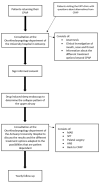Personalized Treatment for Obstructive Sleep Apnea: Beyond CPAP
- PMID: 39202749
- PMCID: PMC11355307
- DOI: 10.3390/life14081007
Personalized Treatment for Obstructive Sleep Apnea: Beyond CPAP
Abstract
Obstructive sleep apnea (OSA) is a sleep disorder characterized by repetitive episodes of partial or complete obstruction of the upper airway during sleep. Continuous positive airway pressure (CPAP) is a method used as a first-line treatment for obstructive sleep apnea (OSA). However, intolerance and resistance to CPAP can limit its long-term effectiveness. Alternative treatments are available, such as Mandibular Advancement Devices (MADs), positional therapy, upper airway surgery, and maxillomandibular osteotomy. However, often less efficient in reducing the apnea-hypopnea index, the higher tolerance of and compliance to alternative treatment has resulted in the adequate treatment of OSA in CPAP-intolerant patients. This paper describes the protocol of a prospective single-center cohort study including adult patients with moderate to severe OSA (15 events/h ≤ apnea-hypopnea index (AHI) < 65 events/h) that failed to comply with CPAP therapy. Selected patients will be invited to the clinic to explore alternative treatment options where DISE will be a first step in further identifying upper airway collapse during sleep. By exploring alternative treatment options in CPAP-intolerant patients and systematically documenting their treatment paths, an algorithm can be defined to better guide patients towards personalized treatment for OSA. The follow-up is aimed at 5 years with an inclusion of 170 patients per year, including a drop-out rate of 15%. By leveraging a real-world database, this study aims to bridge the gap between research and clinical practice, facilitating the development of evidence-based guidelines and personalized treatment algorithms for CPAP-intolerant patients.
Keywords: CPAP intolerance; alternative treatment; obstructive sleep apnea; personalized medicine.
Conflict of interest statement
S.O.d.B. holds a Junior Postdoctoral Fellowship at Research Foundation Flanders (FWO, 1299822N). OV holds a Senior Clinical Investigator Fellowship at Research Foundation Flanders (FWO) (1833517N).
References
LinkOut - more resources
Full Text Sources
Medical
Miscellaneous


